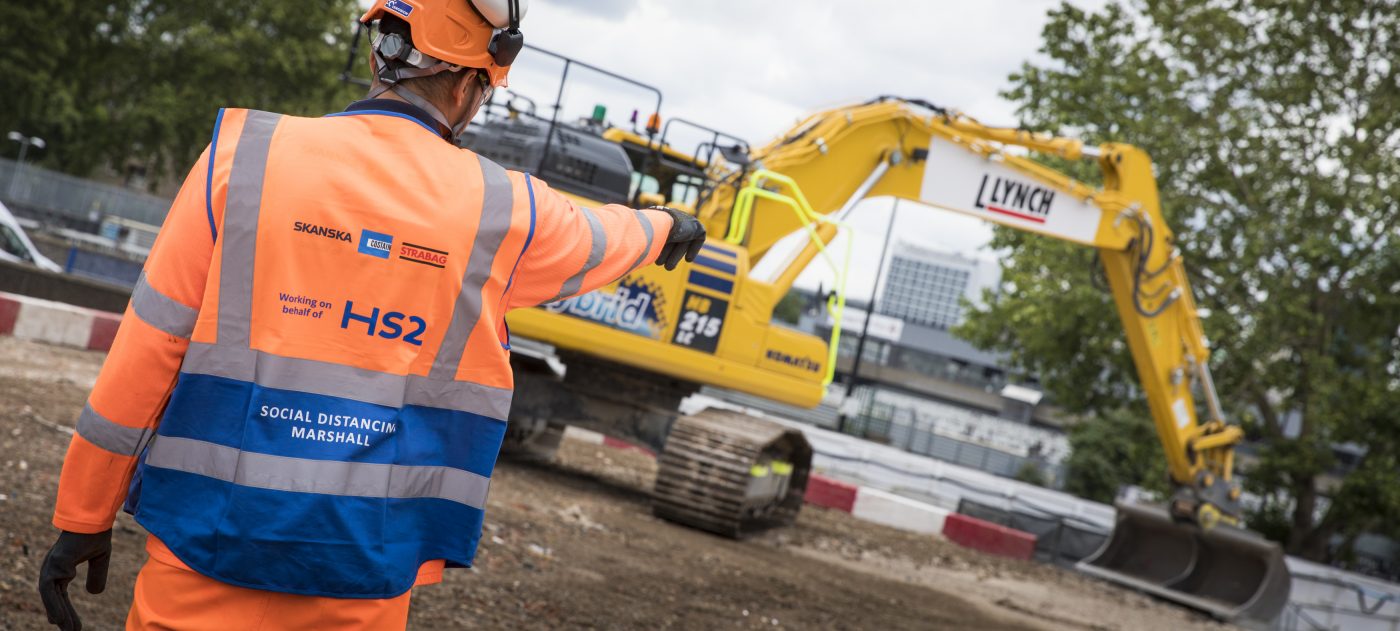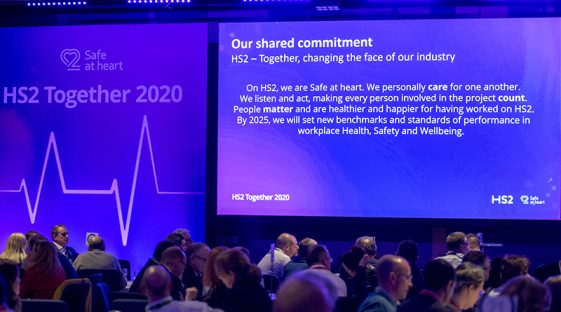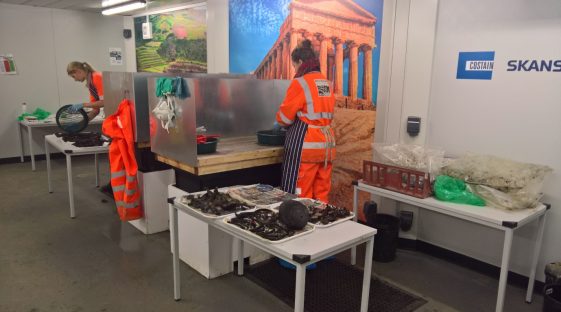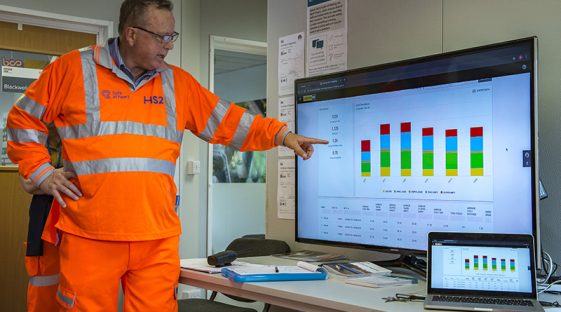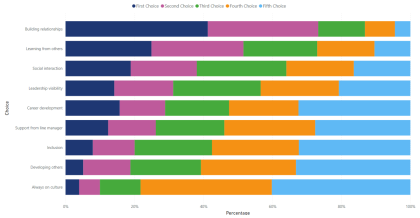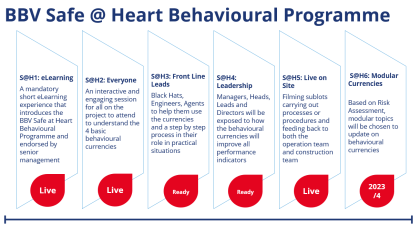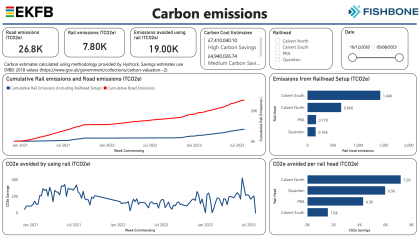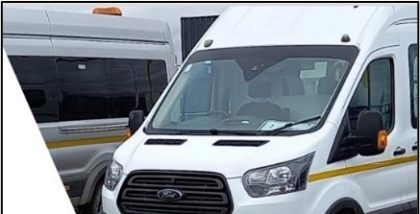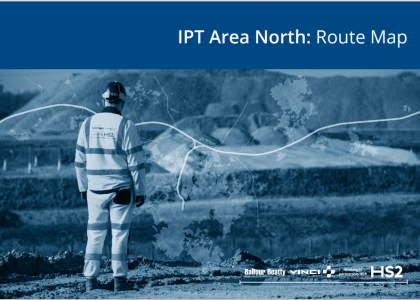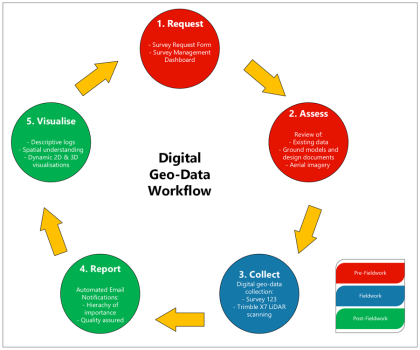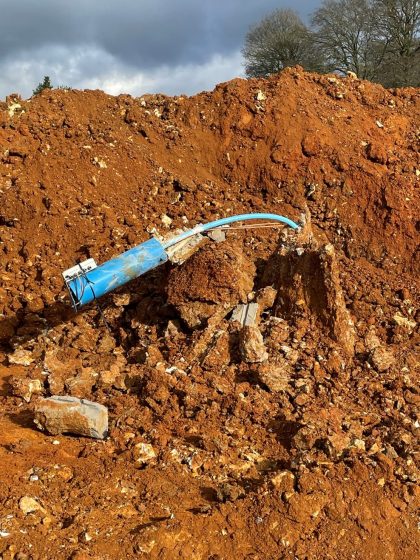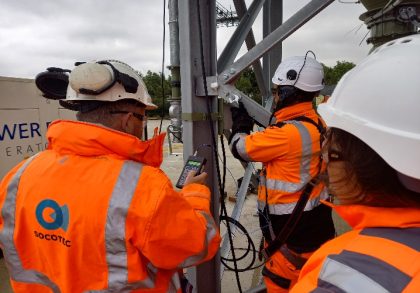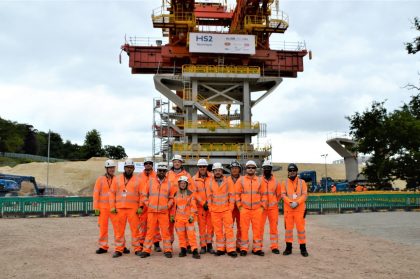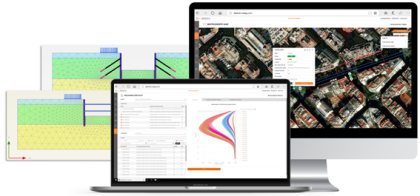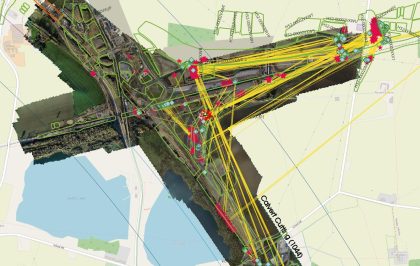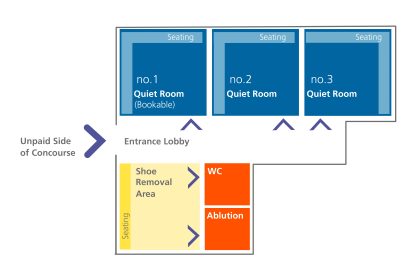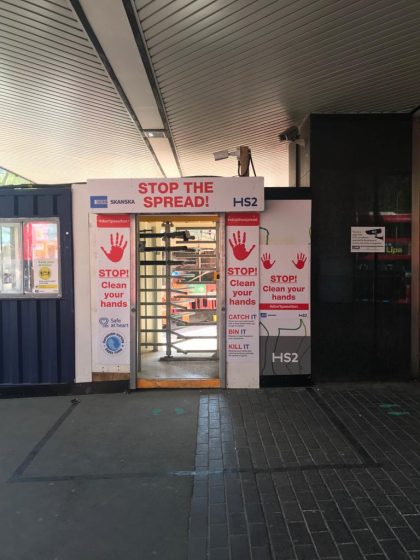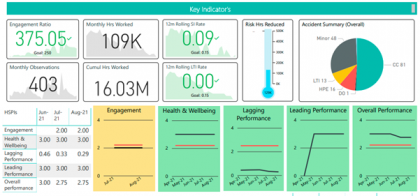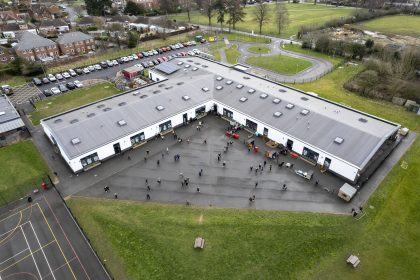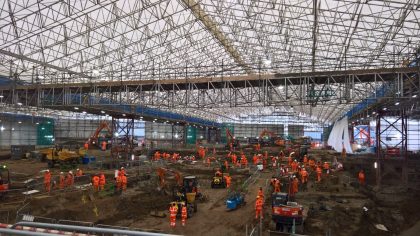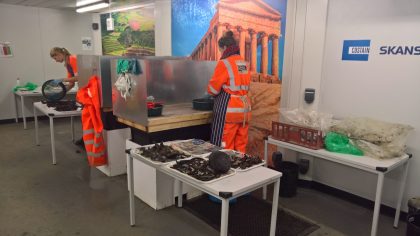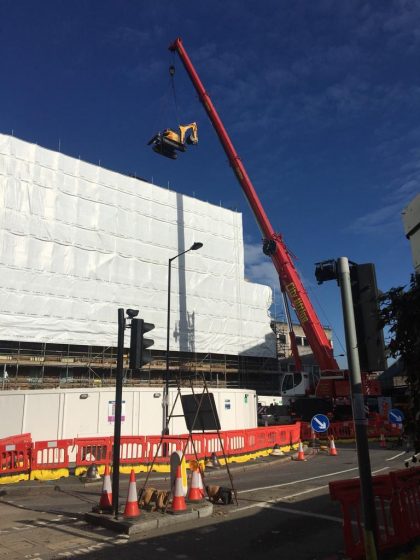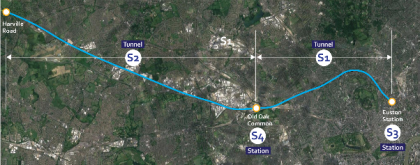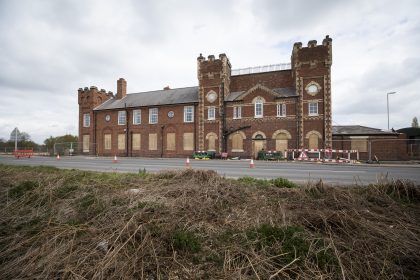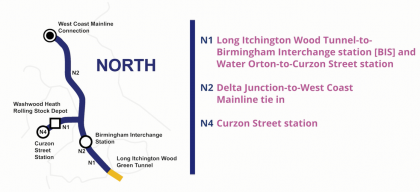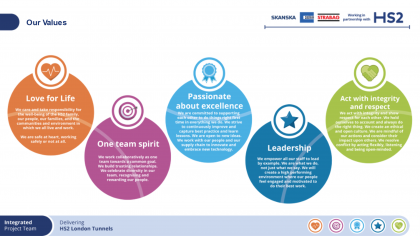Health, Safety and Wellbeing
This theme covers the effective management, removal and control of health and safety risks from the work environment, and the management of the wellbeing of people.
Topic areas
Health, Safety and Wellbeing Resources
Resources include papers, videos, research summaries and good practice documents produced by authors from across the HS2 Family to capture learning, good practice and innovation from the HS2 programme
-
Published on
HS2 back to better programme-Building organisational resilience post COVID-19
HS2 Ltd and its delivery partners in the supply chain established the Back to Better Programme to implement consistent and effective control measures for work sites in line with its seven Safe at Heart focus areas to mitigate the impacts of COVID-19. This would provide clarity, information and guidance to the supply chain to allow…
-
Published on
BBV behavioural programme ‘Safe at heart’
Safety is at the heart of everything the High Speed Two (HS2) programme does. This paper describes the behaviour safety programme that was developed by Balfour Beatty VINCI (BBV) - the Main Works Civil Contractor for the northern section of HS2 Phase One - to drive a safety culture for all staff, contractors, and the…
-
Published on
Materials by Rail (MbR) to HS2 on-site stockpiles
The efficient distribution of construction materials, fully compliant with HS2’s ambition to be carbon neutral and considerate to its neighbours, presented a unique range of materials challenges and it became obvious that Materials by Rail (MbR) would play a significant part. The alternative MbR strategy Ref: RAT EK MbRRail 290819[1], developed by the rail specialists…
-
Published on
Align worker travel service
The Align JV worker travel shuttle service was established in early 2020, with the aim of providing a safe and efficient mode of transport for staff working on the Align JV HS2 C1 project. It consists of a fleet of 18 minibuses and 19 drivers. The free-to-use service has produced an environmental, safety and efficiency…
-
Published on
HS2 Area North Route Map Tool
The Route Map was developed to provide an oversight of the entire works of the Main Works Civils Contract (MWCC) Area North with detailed summaries of each sublot, enabling stakeholders to better understand the works across the BBV Integrated Project Team (IPT). Information Management, Sublot Directors and the Communication team worked together to develop the…
-
Published on
Kudos for all
Design House JV is approaching the end of a challenging Phase 1 delivery period. A team of organisational psychologists created an employee recognition system called Kudos, to boost morale and wellbeing amongst employees. Statistically 70% of employees who experience more gratitude at work report fewer depressive symptoms and stress, and benefit from improved satisfaction and…
-
Published on
Safe at Heart: establishing an inclusive and safe culture for our employees
The construction industry has a reputation for lacking inclusivity facing challenges such as the underrepresentation of women, BAME individuals, and LGBTQ+ employees. This paper discusses the approach taken by Balfour Beatty VINCI’s (BBV) (joint venture collaboration with HS2 to deliver the main works civils contract for HS2 Area North) to establishing an inclusive and safe…
-
Published on
Construction stage geo-data collection, reporting and visualisation – digital workflow
This paper presents an innovative digital workflow designed to address the challenges associated with collecting, reporting, and visualising construction stage geological and geotechnical ground data (geo-data). It emphasises the importance of this data in informed decision-making, to achieve efficiencies, optimisation, and, most importantly, risk assessment and mitigation. The limitations of traditional geological mapping workflows and…
-
Published on
Safe borehole casings reductions for instrumentation and monitoring installed in cuttings
This paper is presented as part of the works to deliver the Main Works Civils Contract (MWCC) for the central section of High Speed Two (HS2) Phase One which includes the North Portal Chiltern Tunnels to Brackley and Brackley to South Portal of Long Itchington Wood Green Tunnel, being delivered by the EFKB Integrated Project…
-
Published on
Control of hand and arm vibrations on HS2 and beyond
Hand Arm Vibration Syndrome (HAVS) is a health condition caused by the vibration from any hand-held, fed or guided power tools and machinery on site, e.g. drills, torque wrenches, plate compactors etc. HAVS causes damage to muscles, nerves, joints and blood vessels, leading to permanent long-term health. Over two million people in the utility and…
-
Published on
Innovative Logistics: Construction Consolidation Centre – HS2 C1 ALIGN
This paper focusses on the Main Works Civils Contract (MWCC) for the central section of High Speed Two (HS2) Phase One which includes the Colne Valley Viaduct and Chiltern Tunnels, being delivered by the ALIGN Integrated Project Team (ALIGN). The paper summarises the established benefits and lessons learned from the implementation of an in-house Construction…
-
Published on
Enhancing the observational method through digital innovation
DAARWIN[1] is a web platform that refines geotechnical design models using data collected from site. It compares the design prediction against the measured response to enable a more accurate understanding and future analysis of the ground and ground-structure interaction behaviours. This paper describes how this was trialled on HS2. The primary aim of the trial…
-
Published on
Re-use of excavated materials
This paper focusses on the sustainable re-use of excavated earthworks materials and the lessons learned as part of the EKFB journey. The objective for EKFB, as the main works contractor for C2 and C3 of the HS2 route, is to maximise the re-use of materials and minimise off-site disposal. This has been achieved through the…
-
Published on
A new standard for health and well-being: HS2 quiet spaces technical specification
HS2 Ltd has strategic goals for setting new standards for customer experience and health and safety in the operation of the railway and therefore requires its designers to take an inclusive design approach so that infrastructure is designed for the people who use it, both customers and staff. Providing quiet spaces for people from religious…
-
Published on
Occupational Health & Wellbeing: additional site vigilance during Covid
On the 24th March 2020, CSjv initially paused in response to the introduction of “lockdown” measures as a result of the COVID-19 pandemic. CSjv recommenced where safe to do so, introducing new ways of working to ensure compliance with social distancing guidance to prevent the transmission of COVID-19. To ensure these changes were successful, a…
-
Published on
Managing leavers to mitigate the impact to project delivery
After the peak of works, many Costain Skanska joint venture (CSJV) team members were offered roles with follow-on High Speed 2 (HS2) contracts which delivered on career progression and job security. The knowledge and experience gained on the Enabling Works Contract (EWC) made these individuals highly sought after. The impact on CSJV resulted in prematurely…
-
Published on
Female Advocates in Rail (FAIR) Network
Establishing employee networks provides a safe, supportive space for women and other minority groups on a construction project. This paper details how site-specific equality, diversity and inclusion support can be set up and supported by contractors, focusing on the joint venture context.
-
Published on
PowerBI and its use in performance management reporting
Monthly reporting utilising Excel dashboards proved to be time consuming, require numerous efforts to provide consistent presentation and was not readily providing the detailed information required to enable prompt effective decisions to be taken by the relevant management teams. With the switch to PowerBI, significant benefits were achieved in terms of time savings, consistent presentation,…
-
Published on
Creating a legacy through social value
The Enabling Works Contractor (EWC) on the southern section of HS2 undertook a revolutionary approach to creating legacy through opportunities for skills, jobs, education and the economy by its investment in social value across the route. By working closely with suppliers and stakeholders, the EWC looked to attract, develop, and retain a diverse workforce with…
-
Published on
School Engagement – Noise risks
Health and safety was a key part of educational engagement programmes on the High Speed Two (HS2) Enabling Works Contract central section. One effective initiative was a focus on noise safety and hearing health awareness within the school engagement offering. This included: joining forces with a hearing conservation charity; running a workshop for 180 students…
-
Published on
Engineering for archaeology during major infrastructure programmes
Archaeological activities are often the first piece of work carried out under the auspices of a Principal Contractor. However, they are not always afforded the same scrutiny when it comes to risk reduction and innovation. This short paper seeks to address this by identifying ways in which archaeological works can set the tone for safety…
-
Published on
Managing Occupational Health risks in archaeology
Archaeology is traditionally a challenging, hands on and physical job with the potential to present a number of occupational health challenges. By strategically examining activities and work streams it has been possible to introduce new tools and techniques to reduce harm and improve productivity in both fieldwork and laboratory environments. Provision of small electric plant,…
-
Published on
Quantifying risk hours to assess safe working systems
An approach to quantifying risk savings made in the risk review process has helped demonstrate safer methods working on the High Speed Two (HS2) Enabling Works Contract South. By quantifying the hours of persons who were undertaking high risk activities, it could be seen if alternative methods of working were safer. This approach fundamentally changed…
-
Published on
Health & safety improvement: safety culture management
This paper gives an overview of the learning that Costain Skanska joint venture (CSjv) has embedded through the deployment of a safety culture measurement tool over a period of three years on the High Speed Two (HS2) - Enabling Works Contract (EWC) South programme of works. As a result of the implementation, CSjv have recorded…
-
Published on
Improving dynamic risk assessments through digital application
Dynamic Risk Assessments (DRA) undertaken on site have traditionally used paper forms. Paper forms can be difficult to complete or become damaged in poor weather conditions, get mislaid and often result in time lags in wider information sharing. The High Speed Two (HS2) Phase 2a team created a digital version of the DRA form. Using…
-
Published on
Building and sustaining a health and safety brand that connects everyone to being Safe at heart
‘Safe at heart’ is HS2’s pan-project health and safety brand and philosophy. After five years, it was failing to resonate with employees and supply chain and connect hearts and minds to the mission of making HS2 the UK’s safest ever mega project. A comprehensive review highlighted the need to clarify health and safety accountabilities, simplify…
-
Published on
Health and safety by design: managing risk on Enabling Works
High Speed Two’s (HS2’s) aspiration is to manage health like safety. The Enabling Works South contractor approached this is by incorporating safety and health risks in a master register, coded by hazard type. Through sharing with the supply chain, nearly 20% of risks were identified as being related to potential occupational health hazards that traditionally…
-
Published on
Managing properties, managing risks – good practice
Throughout the lifecycle of the project, HS2 Ltd will be landlord to a large property portfolio, which is managed and maintained by a specialist property management supplier. A suite of health, safety and environmental standards expected from HS2’s property management supplier was defined following an industry benchmarking exercise. This clear expectation has resulted in improved…
-
Published on
Innovative approach to CDM coordination
With High Speed Two (HS2) construction works and all the associated enabling and utility works requiring many organisations to coordinate their work activity teams at hundreds of locations, the HS2 project gave the perfect opportunity to improve collaboration and planning of works with a web based Geographic Information Systems (GIS) linked to a work activity…
-
Published on
Love for Life: Preconstruction Injury Free Environment
During the early stages of the southern section of the main works contract for High Speed Two (HS2) Phase one, the contractor team recognised the importance of applying behavioural principles to design and other preconstruction functions, such as procurement, planning and commercial. The project adapted the contractor’s successful construction-based Love for Life behavioural programme, in…

